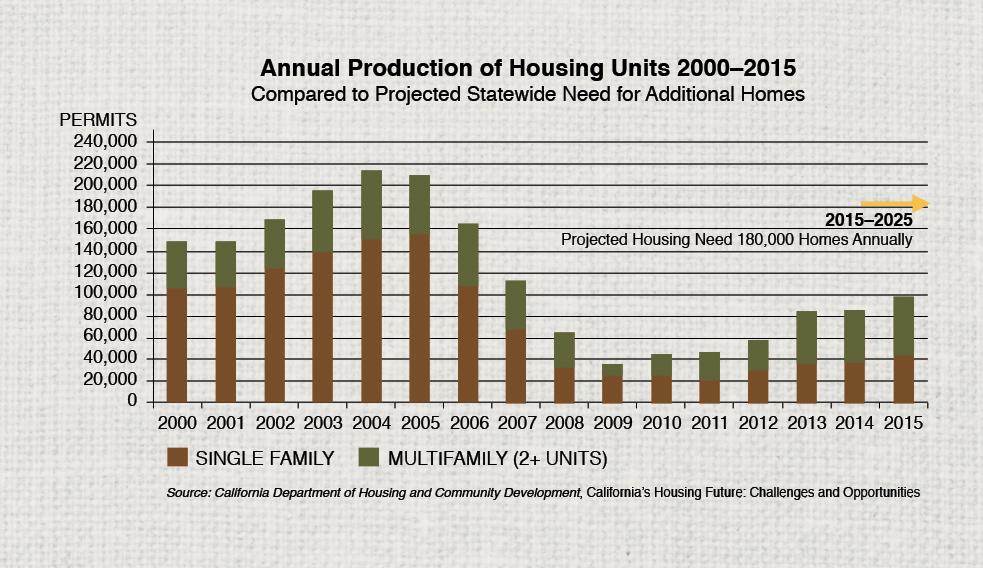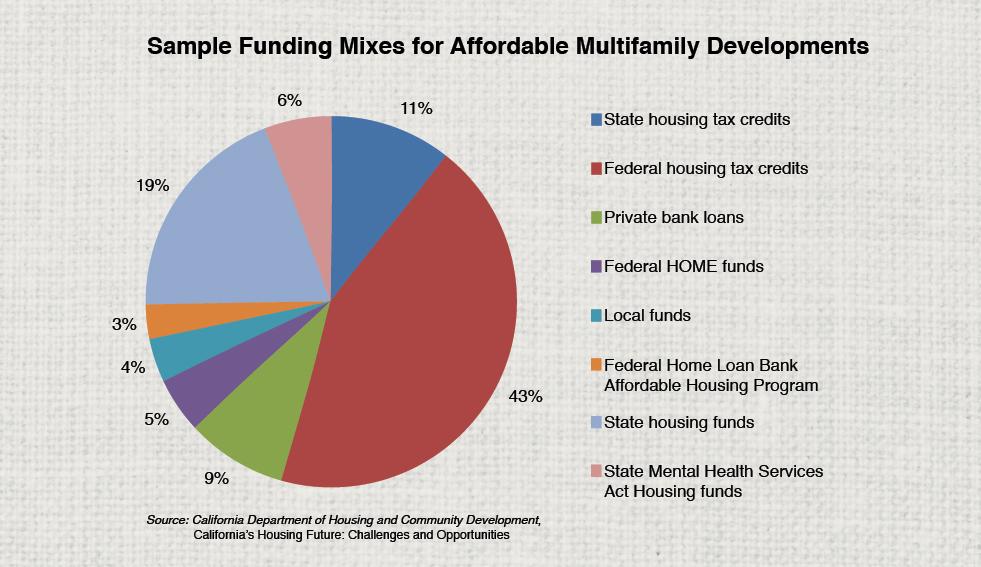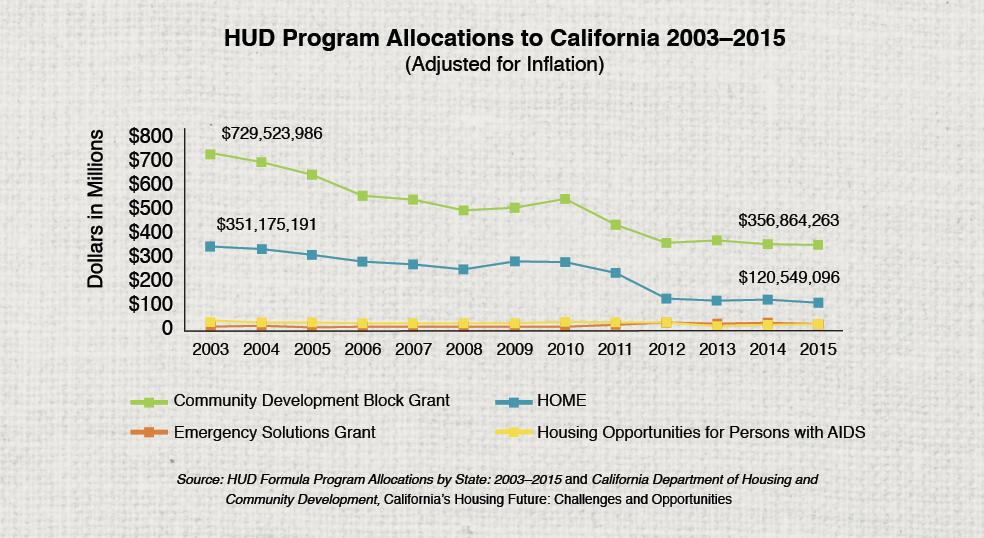Finding Solutions to the Affordable Housing Shortage
Housing affordability is an urgent issue in California, where a majority of renters (over 3 million households) pay more than 30 percent of their income toward rent and nearly one-third (over 1.5 million households) spend more than 50 percent of their income on rent. In addition, California’s homeownership rates are at the lowest point since the 1940s. That’s why improving the affordability of workforce housing and securing additional funds for affordable housing is a strategic priority for the League in 2017.
Principal Causes of the Affordable Housing Shortage
Local governments are just one piece of the complex scenario that comprises the housing development process. Cities don’t build homes — the private sector does. In California, local governments must zone enough land in their General Plans to meet the state’s projected housing demand; however, cities don’t control local market realities or the availability of state and federal funding needed to support the development of affordable housing. This is true not just in California but nationwide, as I have observed firsthand in my work with the National League of Cities in Washington, D.C., and as a former deputy mayor for the City of Indianapolis.
Significant barriers and disincentives constrain the production of housing. These include:
- Local and national economic and job market conditions;
- Lack of funding and subsidies needed to support housing that low- and moderate-income families can afford; and
- Challenges for developers.
It’s important for city officials to understand these constraints so they can increase awareness among our residents and other stakeholders as to why California has an affordable housing crisis and invite them to participate fully in identifying and crafting solutions.
Local and National Economic and Job Market Conditions
Numerous factors contribute to local and national market conditions that affect the availability of affordable housing. The economic recovery from the Great Recession, when many middle-income families lost their homes to foreclosures, has occurred at different rates in communities throughout California. Areas with high-tech industry and some coastal areas recovered more rapidly than other regions.
Overall, the recovery has been uneven. Jobs in manufacturing and blue-collar industries have not fully rebounded, and jobs in the expanding service sector pay lower wages.
Many households are still struggling to recover from the recession and home foreclosure crisis, and many recent college graduates are carrying significant debt — reducing their ability to purchase a home or pay rent.
Mortgage underwriting standards became more stringent in the aftermath of the foreclosure crisis, which can make it more difficult for potential homebuyers to qualify for the needed financing.
Some of the state’s major homebuilders went out of business during the recession, leaving fewer companies to meet the demand for housing. Production of housing fell dramatically during the recession, which contributed significantly to a shortage of homes across the affordability spectrum. As the chart “Annual Production of Housing Units 2000–2015”(below) shows, housing “starts” statewide are at about half of pre-recession levels and fall far short of the state’s projected need for 180,000 new homes per year.
Housing values also reflect the uneven recovery happening throughout the state. The Wall Street Journal recently compared home prices today to those of 2004. In San Jose, which is part of Silicon Valley where tech jobs pay top wages, prices are 54 percent higher than 2004 levels, but this is not so in areas hindered by a slower recovery from the recession. In Central Valley cities such as Stockton and Merced, housing prices are 21 and 16 percent lower respectively.
Lack of Funding and Subsidies
In addition to private sector financing, funding and subsidies to support the development of affordable housing come from two primary sources: federal and state government housing programs.
It’s extremely rare for a single affordable housing program to provide enough funding to finance an entire development, due to the costs of development and funding constraints and criteria that encourage developers to leverage other funds. The developer will typically apply for funding from multiple programs and private sector lenders that have overlapping policy goals and requirements. Private-sector lenders may also have additional criteria. The process of applying for and securing funding from multiple sources can add significantly to the lead time needed to start construction.
One multifamily development can easily need five to 10 funding sources to finance its construction. Developers generally layer financing from state and federal tax credits, state housing programs, local land donation and other local grants, federal housing programs and private loans from financial institutions. The chart “Sample Funding Mixes for Affordable Multifamily Developments” (below) offers an example of funding mixes for affordable multifamily developments.
Federal funding for affordable housing comprises a significant portion of California’s resources to support affordable housing. However, due to pressures to cut federal spending and reduce the deficit, federal funding for housing has declined in recent years despite the increase in the number of severely cost-burdened, low-income renter households (which rose from 1.2 million in 2007 to 1.7 million in 2014). Between 2003 and 2015, CDBG and HOME funds allocated to California to produce affordable housing units have declined by 51 percent and 66 percent respectively (see “HUD Program Allocations to California 2003–2015” below).
Furthermore, few sources of affordable housing funding are stable or growing from year to year despite an increasing population and demand for housing. This funding uncertainty deters both efforts to address housing challenges in a sustained manner and developers’ ability to build affordable housing.
At the state level, the elimination of redevelopment agencies and the subsequent loss of over $5 billion in funding since 2011 compounded California’s affordable housing challenges. The state has never had a significant permanent source of affordable housing funding, and proceeds from the 2006 housing bond that helped create and preserve affordable apartments, urban infill infrastructure and single-family homes have been expended.
With pressure continuing in Washington, D.C., to close the deficit, the limited resources that cities have relied on from the federal government are likely to continue to be under attack or at risk for the foreseeable future. At the state level, Gov. Brown’s proposed budget for 2017–18 does not include any additional state funding for affordable housing. This decline in federal funding and the lack of state funding continue to have a profound impact on the availability of affordable housing.
A recent report from the state Department of Housing and Community Development (HCD), California’s Housing Future: Challenges and Opportunities, examines in detail many of the issues described here. However, policy responses must start with restoring a sufficient source of funding for affordable housing.
Challenges for Developers
In addition to funding challenges to develop affordable housing, other challenges further exacerbate the obstacles to development, including:
- Identifying an adequate supply of water;
- Complying with state regulations and energy standards, greenhouse gas reduction requirements and other environmental conditions;
- Competing with other developers to build high-end, more expensive housing;
- Infrastructure deficits;
- Market conditions, such as those described earlier; and
- The cost of land and construction.
Other Factors
In addition — but to a far lesser degree — factors at the local level can also impact the development of affordable housing. In some cities, new development requires a referendum and voter approval. Community concerns about growth, density and preserving the character of an area may affect local development. Project opponents can use the environmental permitting process and litigation to limit or stop a project. However, the process of complying with the California Environmental Quality Act also serves to protect communities by ensuring that important environmental issues are identified and addressed.
Impacts of the Affordable Housing Shortage
The shortage of affordable housing and the rising costs of developing affordable housing for the workforce are compounding a growing inequality statewide. This also limits employment opportunities for California workers and advancement opportunities for younger adults who can’t afford to live near their place of work or in areas where jobs are available.
Although California comprises 12 percent of the nation’s population, it is home to 22 percent of the nation’s homeless population. The need for affordable housing for these individuals and families is urgent and relentless; it affects virtually every community in the state.
And for people with disabilities and our most vulnerable residents, according to HCD, “Discrimination and inadequate accommodations are worsening housing cost and affordability challenges.”
What Is Needed to Craft Solutions
We can waste time pointing the finger of blame at local governments and others for the housing shortage or we can ensure that the tools we have are robust, efficient and effective.
Three relatively new tools (see “New Tools for Building Communities” below) offer innovative opportunities for communities to build affordable housing — however, unlike the redevelopment tools of the past, these require collaborative, creative approaches.
The League’s strategic priority on affordable housing calls for us to: “Increase state and federal financial support, reduce regulatory barriers, and provide additional incentives and local financial tools to address the affordability of workforce housing and increase the availability of affordable housing.”
The affordable housing shortage is a quality-of-life issue that affects each of us. Local governments stand ready to be part of the solution, and we invite the state and affordable housing stakeholders to join us. We take our responsibility seriously.
As mentioned earlier, it’s vitally important to raise our residents’ awareness of the underlying causes of the affordable housing shortage so they can be active participants in developing solutions. Public engagement in local and state policy-making is a core value for California, and our residents deserve and expect to have a voice in decisions that impact their community. Their participation enriches and informs the process — it is essential.
To address the affordable housing crisis and develop viable solutions, we need all the players and stakeholders at the table — developers, the financial community, residents, business owners and representatives from local government and state government — to begin discussing innovation and creativity. A real solution must involve everyone at the table. We welcome your ideas, suggestions and input. Let’s get to work.
Federal Funding Details
Federal funding for affordable housing works to increase the supply of affordable housing by providing tax credits, grants or loans to support housing production or rehabilitation. Some federal programs can also lower the cost of rental housing by providing rental assistance that reduces the rent paid by an income-eligible household, but allows the property owner to collect rents that are closer to market-rate levels.
The U.S. Department of Housing and Urban Development (HUD) allocates funding for affordable housing directly to larger cities and urbanized counties through four main grant programs:
- Community Development Block Grant (CDBG) Program is designed to benefit low- and moderate-income families and funds local community development activities such as affordable housing, anti-poverty programs and infrastructure development;
- HOME Investment Partnerships Program (HOME) supports affordable housing, particularly for low- and very low-income individuals;
- Emergency Solutions Grant Program helps individuals and families quickly regain stability in permanent housing after experiencing a housing crisis or homelessness; and
- Housing Opportunities for Persons With AIDS (HOPWA) provides housing assistance and related supportive services to meet the housing needs of low-income individuals living with HIV/AIDS and their families.
HUD also provides funding through these programs to the states that, in turn, make subgrants to smaller cities.
New Tools for Building Communities
The following three tools, created to help local governments with affordable housing development, offer new ways to develop affordable housing.
Recent legislation, AB 2031 (Bonta, Chapter 453, Statutes of 2016), established Affordable Housing Beneficiary Districts within the same geographical boundaries of the jurisdiction’s redevelopment agency successor agencies. This law allows a jurisdiction to redirect its distribution of property tax revenue payable to the city or county from the Redevelopment Property Tax Trust Fund to the affordable housing beneficiary district for as long as the successor agency exists. The jurisdiction is then authorized to issue bonds against the property tax revenue to provide financial assistance in the form of loans, grants and other incentives to develop affordable housing.
Enhanced Infrastructure Financing Districts (EIFDs), enacted via SB 628 (Beall, Chapter 785, Statutes of 2014) are a relatively new tool that can fund housing, transit priority projects, sustainable communities strategies, military base reuse, brownfields restoration and more using tax-increment financing. They may not redirect property tax revenue from K–14 schools, but can provide funding for a wide range of uses similar to redevelopment agencies if the participating affected taxing entities agree to provide their tax-increment revenue to the EIFD.
Community Revitalization and Investment Authorities (CRIAs), enacted via AB 2 (Alejo, Chapter 319, Statutes of 2015), provide another new way for local governments to fund various types of economic revitalization programs, including low- and moderate-income housing, using tax-increment financing.
Additional Resources
State of California Department of Housing and Community Development California’s Housing Future: Challenges and Opportunities (Public Draft)
A Summary of California Tax-Increment Financing Tools for Community Economic Development
Photo credits: Andy Dean Photography/Shutterstock.com (doormat)
This article appears in the March 2017 issue of
Western City
Did you like what you read here? Subscribe to Western City







